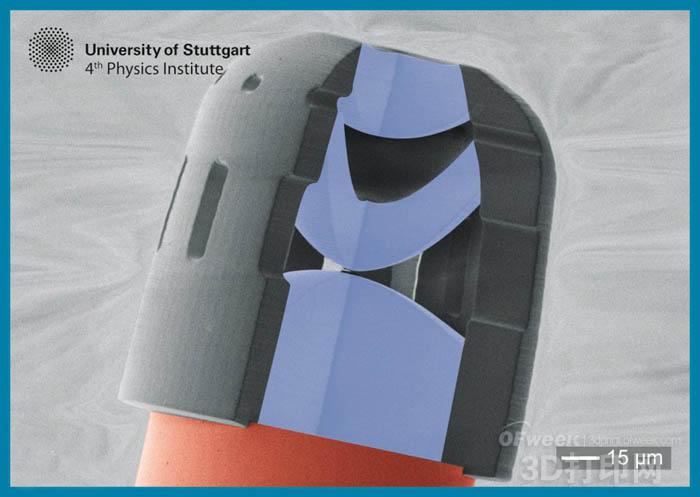A few days ago, scientists used 3D printing technology to create the world's smallest optical lens. The 3D printing lens is only as large as the diameter of two hairs. The microscopic device is said to allow spies to create surveillance cameras that are not as large as a salt. With this technology, spies and police can spread millions of such devices throughout the city, they are completely invisible, so people will not know if anyone is monitoring them.
It is understood that this needle-sized device captures and transmits very sharp photos that can be printed on the tip of an image sensor or endoscope.

Electron microscope image of this 3D printed microlens
Moreover, although it is only about 0.1 mm thick - equivalent to the thickness of a piece of paper, it is possible to manufacture multiple lenses of any shape as needed.
So how is it made? It is reported that Dr. Timo Gissibl and his colleagues from Stuttgart University in Germany have used a device that emits short pulses of light to harden the material to create the 3D multi-lens system.
During the test, the researchers printed a three-lens system at the end of a fiber 3D, which was so small that it could even be inserted into the syringe needle.

3D printed micro lens and a hair
Scientists say they succeeded in recreating the 3mm object captured by the lens at the other end of the 1.7-meter-long tube—which means it could completely subvert the type of internal examination and surgery that is often used. Medical camera.
Dr. Gissibl called this approach a gateway for 3D printed micro-optics, which has broad application prospects in the next generation of endoscopes, miniaturized robots and drones.
“Because of manufacturing technology limitations, current lens systems are greatly limited in size, shape and size. Non-spherical multi-lens components are highly optical and correct for wide angle and large field imaging. The distortion is needed. So, here we present a new optical concept that overcomes all of the above difficulties and opens up a new field of 3D printed micro/nano optical objects with complex lens designs."

Multi-lens system with a diameter of 600 microns, surrounded by four lenses with diameters below 120 microns
“Our approach has unprecedented applicability and paves the way for 3D printing of many micro-optical devices. Applications include speculum, fiber imaging systems in cell biology, new lighting systems, micro fiber traps, integrated quantum emission. And detectors, micro drones and autonomous vision robots," added Dr. Gissibl.
In particular, the entire optical composite system is manufactured from a single material. The research was published in the June issue of Nature Photonics.
Pull and decoration are the cord's functions.
Blinds Cord
WUXI MIFUN INTERNATIONAL TRADE CO.,LTD , https://www.mifunblinds.com